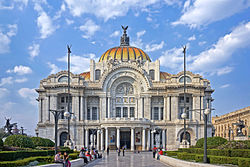
| Part of a series on the |
| Culture of Mexico |
|---|
 |
| Society |
| Topics |
| Symbols |
The architecture of Mexico reflects the influences of various cultures, regions, and periods that have shaped the country's history and identity. In the pre-Columbian era, distinct styles emerged that reflected the distinct cultures of the indigenous peoples of Mexico, particularly in the architecture of Mesoamerica. During the colonial era, the region was transformed by successive styles from Europe. With the foremost style during this era being Mexican Baroque.
In 19th century independent Mexico, foreign architectural influence lead to the gradual rise of Eclecticism, particularly during the Porfiriato. After the Mexican Revolution, there was a nationalist movement in the arts that promoted neo-Mesoamerican styles and a revival of Novohispanic styles.
By the mid-20th century, the nationalist architectural styles began to lose popularity as international architecture movements permeated. Nonetheless, architects during this era designed public and private projects that combined functionalism, regionalism, and modernism to create a distinctive Mexican style of architecture. Most notable among these architects was Luis Barragán.
In contemporary Mexico, the rise of globalization has led to the localization of international movements, including Postmodern, New Classical and Neomodern.
- ^ "National Museum of Architecture". Mexico City. Retrieved 5 October 2023.
© MMXXIII Rich X Search. We shall prevail. All rights reserved. Rich X Search
